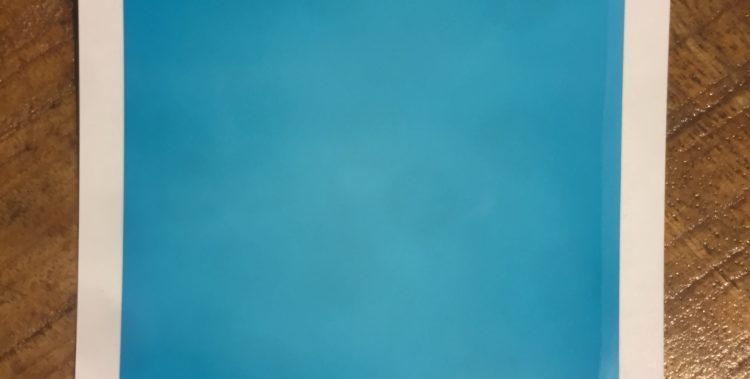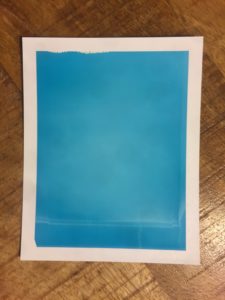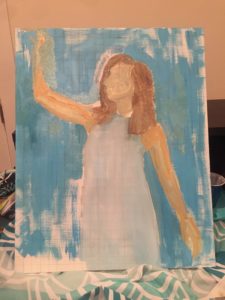
Emily Addis
It starts with thinking. What is a portrait? And what is a person? What am I? The answer to those questions seems to be different depending on who I’m with and what I’m doing. When I think of who I am, I can’t help but think of the important people in my life. Conversations with them help me grasp who I am. Our looks, gestures and emotions are proof of it. There’s someone experiencing the same things as you, which makes it real. That’s what life’s all about: connectedness. So, where does that lead me?
The prospect of making a self-portrait. It’s a bit weird. Maybe it stems from a felt need to represent myself realistically. I don’t want to seem like I’m glorifying myself. But I’m excited to see where this goes.
I ask my friend to show me how to use his Polaroid camera. I take my first photo, pull it out and let it develop. It’s sticky and smells like chemicals, and it gives me a huge thrill. I’m proud to be learning something new. I take several pictures; most come out blurry, but one is actually just how I wanted. I’m excited. In the coming days I keep playing with the camera. I’m living with my brother at the moment, and it’s a time in our lives I want to capture. I like the instant results of the Polaroid. It’s like freezing time. It gives me the power to take what I see in the world and turn it into a physical thing that is both beautiful to look at and a document of my life. Cameras today are so advanced, and so many of the photographs we take are manipulated with computers or smartphone apps. This camera completely eliminates that option. What you see is what is printed in the photograph. It’s very honest. It makes me feel like I am on my way to truly and accurately represent myself and my life in this self-portrait. I feel satisfied and peaceful, and reflecting after each session is part of that.
I’m not sure how this project will develop. I want to make an installation of some sort, a web of photos, inspired by the artist Mary Corey March’s interactive installation Identity Tapestry, which I found on Pinterest.
But then one day I wake up and decide to go buy a canvas. I ride the bus to Blick and back. I’ve been thinking about painting a lot. I miss it. And I want my skills to come through in this project, and my skills are in painting and not necessarily something new. And not to mention this film is very expensive.

I’m still learning to use the camera, though. I’m trying to capture the so-called boring details of my life, because that’s how life really is. It’s not like on Instagram. Sometimes the camera does things that I just don’t understand, like produce a completely blue picture. It used to frustrate me when my pictures didn’t come out right. I would beat myself up a little bit, but then remind myself that I’m learning to take film photographs for the very first time using a tricky camera. I’m starting to enjoy when pictures come out completely wrong. So much that I decide to use them as inspiration for my painting. Like that all-blue one, that’ll be the background color of my painting.
I’m anxious to start painting. There’s excitement, but there’s also nervousness because it’s been a while. Prepping the canvas is meditative. I enjoy the ease and how I empty my mind as I get an even coat of gesso on the canvas. It’s a welcome break from normal life, where I need to keep track of time incessantly.
I take a photo of myself on the computer. I pose like I’m hanging up a photo on the wall, as if it’s a picture of me making the installation of all the Polaroids. I roughly draw the photo in my sketchbook. This is the scary part, having to get the proportions and everything just right. I draw a grid over the sketch to help me transfer the image to the canvas. The grid is not exact, but even so it’s helpful—at least until I abandon it and just draw on the canvas with paint.
A few days later, I really get to painting. I look at the photo and block in shapes. It takes time and several layers before the shapes are right. It’d probably be faster if I drew a thorough sketch first, but I just enjoy the feeling of the brush and mixing colors. I step back every so often to see how the shapes fit together. The only drawback is I don’t have a great setup here; I’m sitting cross-legged on the floor. My body aches every so often. Most of the time I don’t notice it, but when I do, it distracts me. I do some yoga after painting.
This goes on for some time, with my painting happening in spurts of 40 minutes or so whenever I have the time, in the mornings or evenings. I’m always happy to come back to it. I put on music. The quality of the paint is just mesmerizing, especially watching it go onto the canvas. That really sucks me in. It’s seeing the lines I make, being satisfied, and moving on to the next line. I also like the smells of the turpentine and oil—I feel connected to the artists of the past. Now when I walk through the galleries at the Barnes, that smell comes to mind. I hadn’t thought about it in a long time. But now I imagine Picasso, Cézanne, Matisse, Pippin, Soutine and Modigliani in their studios with brushes and jars of oil.
Once while painting I have a curious sensation: I look at my photo for reference, measuring by eyeing my paintbrush, and suddenly I just know how big different parts of my body should be. I suppose it’s based on my knowledge of anatomy and proportions. I don’t even have to look at the photograph; I just paint.
Gradually I move from rendering proportions to rendering light. I mix colors on my palette and create lighter and darker versions of each color. I tend to add yellows to make them lighter and blues/reds to make them darker. I stay away from adding pure black and white, because I don’t want it to look bland. I like when little pops of unexpected color jump out at you in a painting, and I enjoy looking for and discovering them when looking at artworks, so I try and recreate that in my own. One of my favorite examples is one of Cézanne’s still lifes in the Barnes. There’s a blotch of orange paint. Our conservator thinks it was an accident, that he leaned another painting up against that one and it left an ugly scar. When I told her I always notice it, she suggested that Cézanne actually liked the orange smear and so never corrected it. I found that fascinating, as if this very intimate, humanizing moment—an art “accident”—was memorialized in this way. Speaking of the Barnes, it occurs to me that my painting looks a bit like Matisse. I wonder if that’s because I spend so much time looking at Matisse these days.
I near the “hump” of the painting: a period of frustration before I can coast, when I don’t like how it looks. It’s not truly frustration, but I feel it’s not interesting to look at. Painting generally puts me in a good mood, but these flares of frustration rise up. Like today, when I’m painting a flesh tone, an unexpected streak of red appeared on the canvas. No doubt an artifact of my mixing the paint with my paintbrush—what you’re not supposed to do. I try to let it go. Those accidents are the fun part, after all. It’s completely unintentional, but it’s intentional that I leave it. Is lacking thoroughness really a bad thing? Let’s call it carefreeness, a daring to embrace imperfection. We don’t do that very often. I think that’s what Cézanne was getting at.
After the hump, painting feels more technical, less creative. It’s a bit saddening, but still there’s the smell and meditative quality, so it remains enjoyable. There’s also something about spending so much time bringing a picture together, especially nowadays when you can take a picture in an instant on your phone.
I take a lot of breaks. It helps me see what’s out of whack or needs adjusting. It gives me fresh eyes. That’s on both macro and micro levels: I take lots of small breaks in each session, but also sometimes I let weeks pass between sessions.
In one of these breaks, I conceive another project. I make a pair of Amazon boxes into canvases, and I paint moments that struck me, that I wanted to make last forever. One is a sunset in San Diego, and one is looking up at a canopy. They’re abstract and minimalist, with thick planes of color, but with some depth. I think these are self-portraits in a way. No doubt an onlooker would learn a great deal about me. I think I’ll incorporate them into the installation.
No, I’m not done yet. Maybe nothing is ever really done—at some point you just have to cut the thread.

This story was written by Tim Gorichanaz based on interviews with Emil Addis.